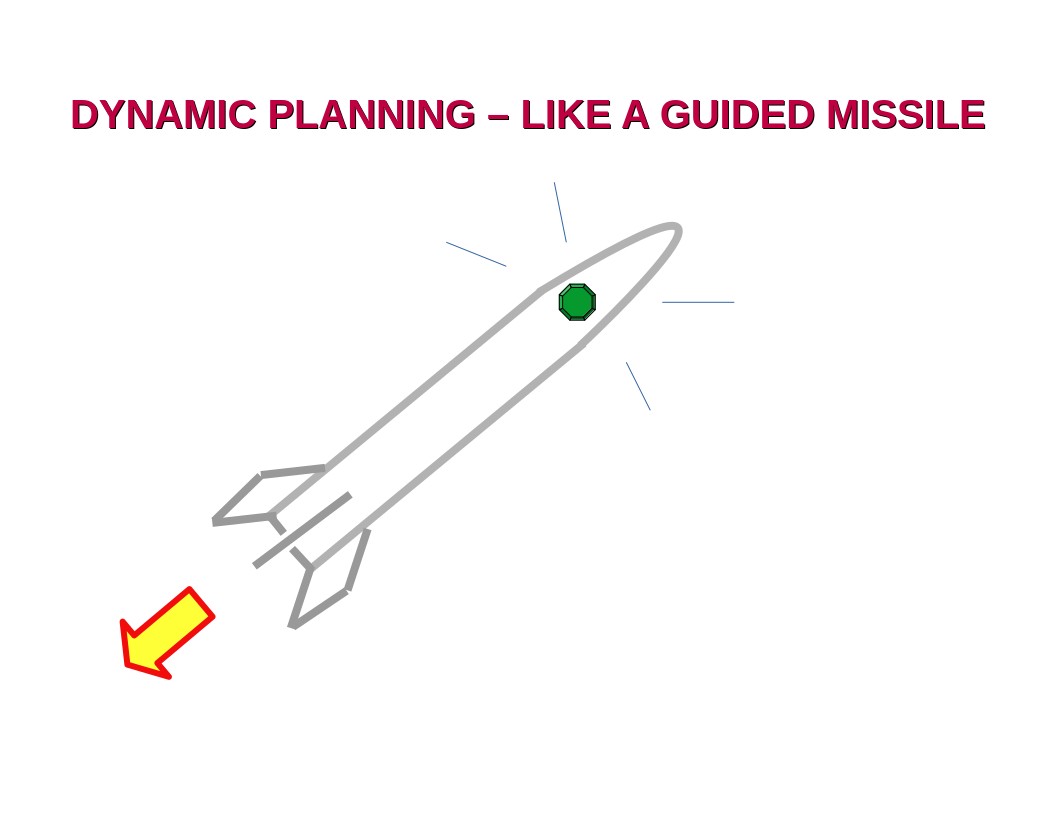A traditional business plan determines action to be taken to accomplish the plan goals and monitors the effect of those actions in reaching the plan goals. If the goals are not reached, the plan is revised and the process repeated. The launch of the business plan is much like the launch of a missile, a rocket that is launched by aiming it and then launching. Of course, a higher level of performance is reached with a guided missile, a rocket that uses a guidance system to steer the missile to a target after the missile has been launched. The guidance system corrects the path of the rocket in flight to assure it intercepts the target. This guidance system may use radar, infrared, laser, or GPS technology, but what is important is that when the missile is launched, the guidance system activates, and the path to the target is tracked. The guidance system will control the missile’s flight path to make adjustments to the missile’s trajectory so that it hits the target. Similarly, a business plan becomes dynamic when the operational decisions made to take actions to accomplish the goals of the plan and results from monitoring these actions are instantly communicated to all involved in the plan such that the actions can be revised to assure plan goals are met. With the traditional business plan process it can take months before monitoring information is reviewed by the policy making group with plans often being revised on a quarterly or even annual basis. A dynamic business plan, like the guidance system of a missile, can allow the actions of the plan to be altered in a timely way to achieve the desired results, even if the initial aim is shown by monitoring to be off target.
The business planning process starts with a strategic idea that develops into a written plan after decisions are made by the policy-making group. The documented plan is communicated from the policy-making group to executive managers who create and implement an operational plan to carry out the plan by meeting its benchmarks (metrics) and goals. At some point, the experience of carrying out the plan as monitored by the executive managers will suggest that the plan be revised by the policy-making group. Traditionally, the segments of the business planning process (strategic, operational, execution, and monitoring) have been viewed as separate activities. This primarily has to do with the traditional means of communicating the plan. The creation of the operational plan by executives will be an iteration of the strategic plan which will alter the strategic plan in a variety of ways that are necessary and appropriate but those changes will not be known by the policy-making group. When the operational plan is initiated and communicated in various ways to the productive elements of the business, as a matter of practicality the effect of the business environment will also cause changes to the plan. These changes also are not brought to the attention of the policy-making group.
The more fluid and dynamic the business planning process, the more the policy-making group will be involved and the more effective the plan will be. The more segmented the planning process, the more restricted the information will be to the policy-making group and the less effective the plan will be. To the extent that the strategic plan is different from the operational plan and does not consider the realities of the marketplace, the success of the plan is in jeopardy. When the plan is changed, either by the drafting of operational planning or the practical aspect of experiencing the reality of the marketplace, it is the reaction to these changes by the policy-making group that will result in the success of the plan by keeping the actions taken to reach plan goals on target.
For a dynamic planning process to exist, any reaction to implementing actions taken to reach the goals of the strategic plan must be communicated to all involved, especially the policy-making group, in a timely manner. Whether this occurs has to do with the communication between the policy-making group, the managers, and the productive elements of the business. What format of a business plan will allow information to flow instantly between these business elements in all directions? Traditionally, it was not unusual to see a strategic plan documented in a three-ring binder that must be handed to an executive group to be read, then communicated to managers by a different means often without documentation, and then placed on a shelf. In due time, managers reported back to the policy-making group after installing and monitoring benchmarks and metrics. Then, the notebook would be pulled off the shelf and revisions would be considered. If the plan is in a three-ring notebook or a PowerPoint slide presentation, the communication of the plan provides an obstacle for the fluid implementation of the plan.
Where a dynamic planning process is in place, the same communication instrument contains the strategic plan, the operational plan, and reflects the monitoring of benchmarks. Deviations from the strategic plan indicated by the drafting of the operations plan, the establishment and monitoring of metrics, and the experience of the marketplace will be communicated to all parties, especially the policy-making group. The planning process (strategic, operational, execution, and revision) is be based on continuous communication. This communication can be done on planning format such as a spreadsheet or perhaps more elegantly by the use of business software such as Microsoft Teams.
Effective execution of the plan is improved where there is overall communication involving the policy-making group and immediate revision to the plan as the necessity is perceived. Like a guided missile.

